Minimalist Living Room Design: A Guide to Simplicity and Functionality
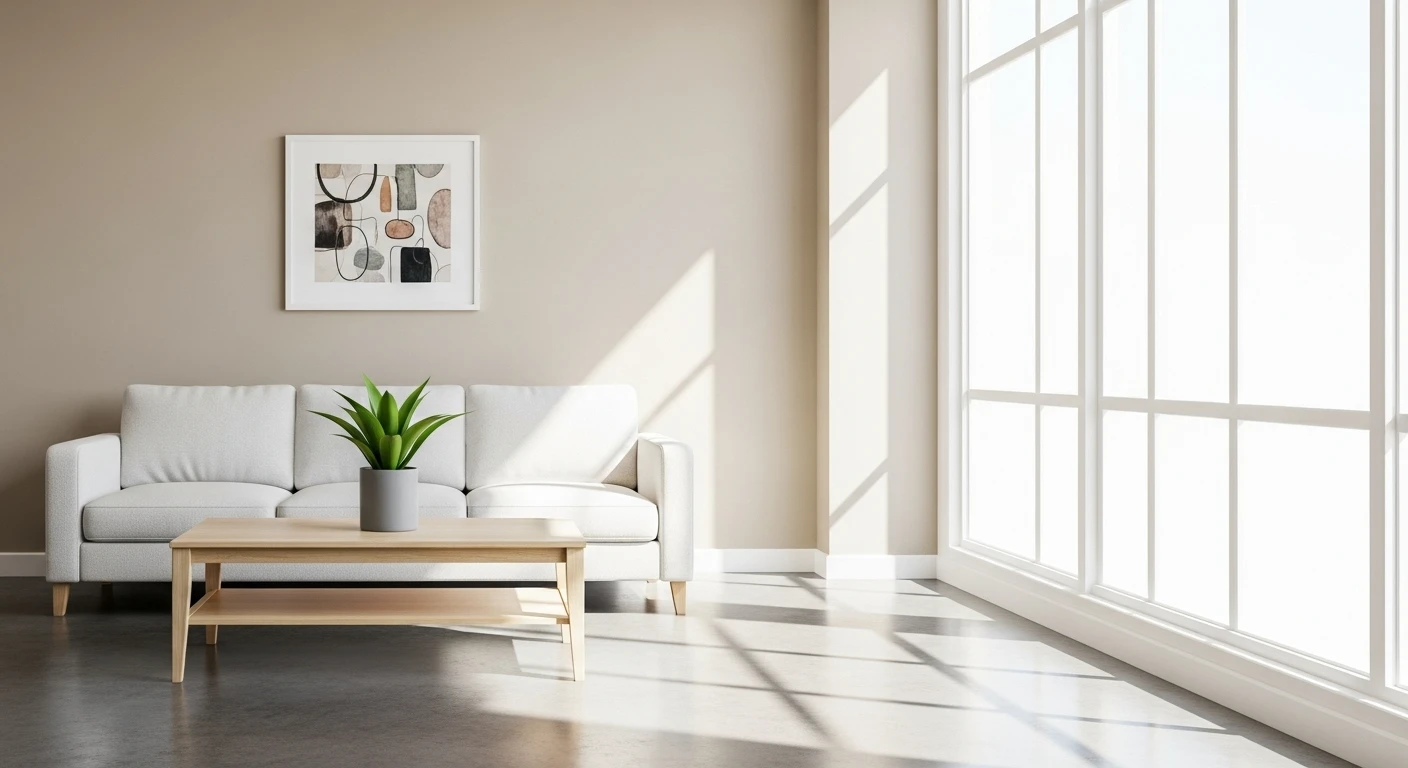
Less is more you’ve probably heard this phrase countless times, but nowhere does it ring truer than in minimalist living room design. If you’re tired of cluttered spaces that feel overwhelming rather than welcoming, you’re not alone. Minimalist design isn’t just a trend; it’s a lifestyle choice that can transform not only your living space but also your daily mindset.
I’ve spent years helping homeowners embrace minimalist principles, and here’s what I’ve learned: creating a minimalist living room isn’t about having less for the sake of less. It’s about being intentional with every piece you choose, creating a space that breathes, and designing a room that truly serves your life rather than cluttering it.
What Is Minimalist Living Room Design?
Before we dive into the how-to, let’s get clear on what minimalist living room design actually means. At its core, minimalism is about stripping away the unnecessary to highlight what truly matters. In living room terms, this translates to clean lines, purposeful furniture choices, and a color palette that promotes calm rather than chaos.
But here’s the thing minimalist doesn’t mean sterile or cold. I’ve seen too many people mistake minimalism for a magazine spread that nobody actually lives in. True minimalist design creates warmth through intentional choices, not through the absence of personality.
A well-designed minimalist living room should feel like a breath of fresh air when you walk in. It should be a space where you can actually relax, not one where you’re constantly worried about disturbing the perfect arrangement.
The Foundation: Understanding Minimalist Principles
Less Is Actually More
The cornerstone of minimalist living room design is the principle that every item should serve multiple purposes or bring you genuine joy. This doesn’t mean your room needs to look like a hotel lobby—it means being selective about what earns a place in your space.
I always tell my clients to start with this question: “Does this piece serve my life or does it just take up space?” If you can’t answer that quickly, it probably doesn’t belong in your minimalist living room.
Quality Over Quantity
When you’re working with fewer pieces, each one needs to pull its weight. This is where the investment mindset comes in. Instead of buying three mediocre coffee tables over the years, invest in one beautiful, well-made piece that will last decades.
Think of it this way: minimalist living room design is like editing a novel. You’re not removing words to make it shorter; you’re removing everything that doesn’t serve the story to make it stronger.
Essential Elements of Minimalist Living Room Design
Clean Lines and Simple Shapes
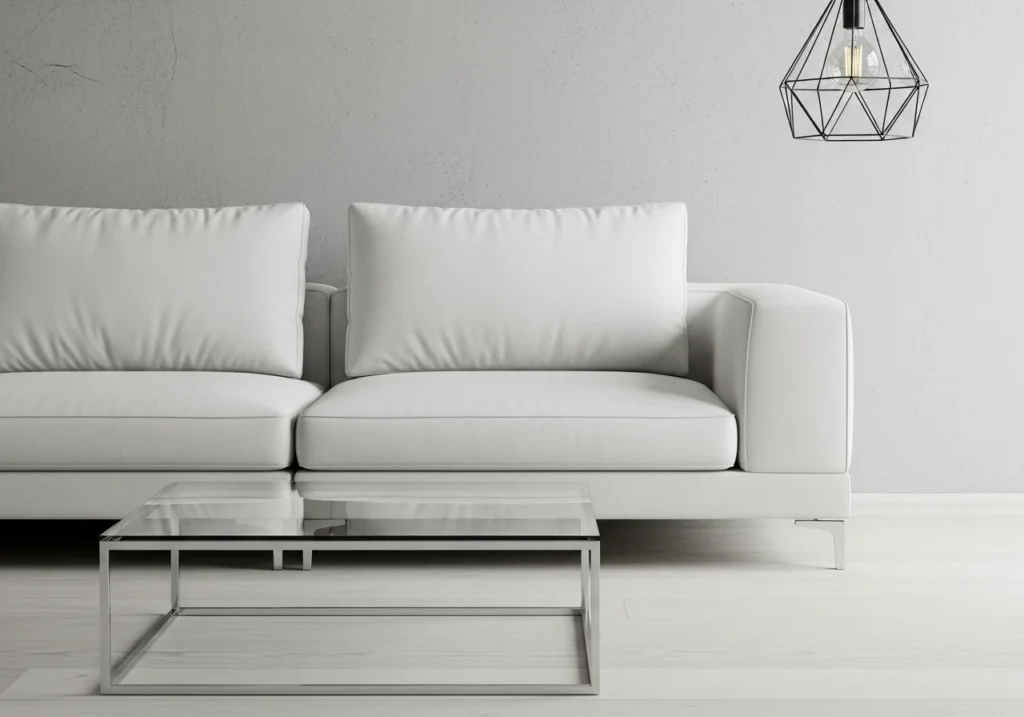
The furniture in a minimalist living room should have clean, geometric lines. We’re talking about sofas with straight edges, coffee tables without ornate details, and shelving that looks almost architectural. These pieces create visual calm because your eye isn’t working overtime to process decorative details.
This doesn’t mean everything has to be boxy, though. You can incorporate gentle curves—think of a sleek curved sofa or a round coffee table as long as the overall form remains simple and uncluttered.
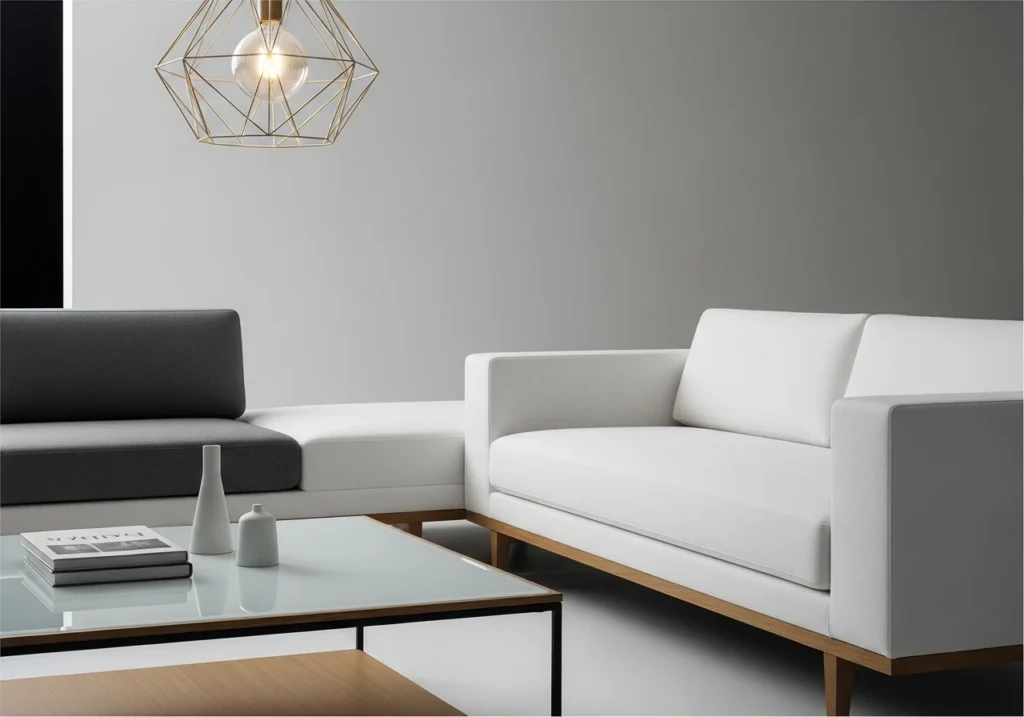
Neutral Color Palettes
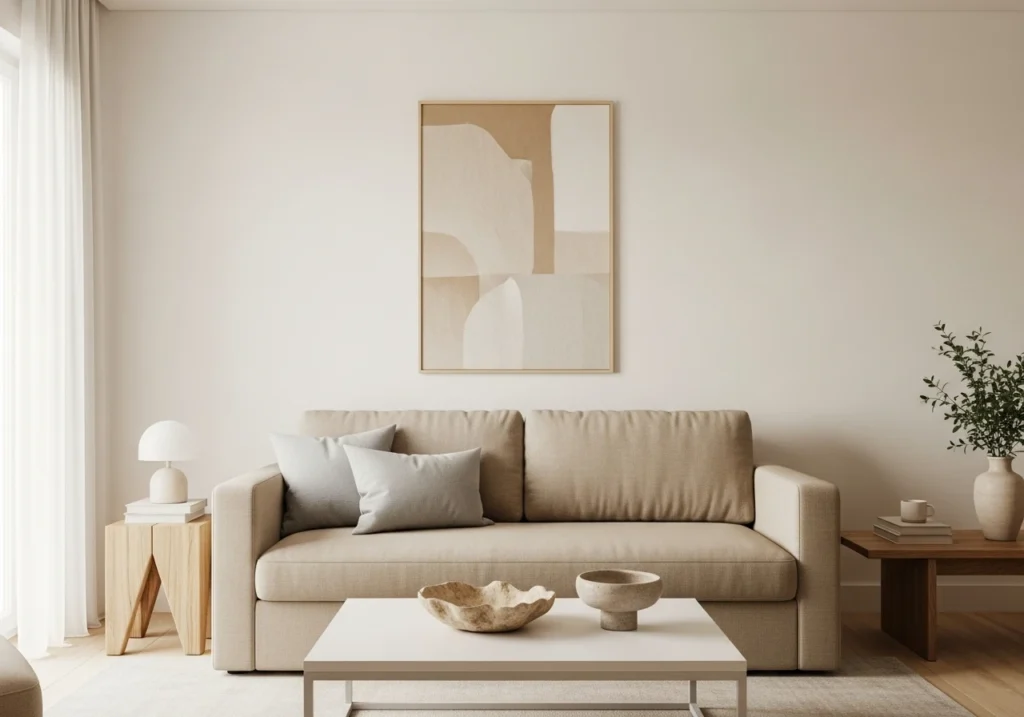
Here’s where minimalist living rooms really shine: the color palette. Whites, grays, beiges, and soft earth tones create a cohesive backdrop that never goes out of style. But neutral doesn’t have to mean boring.
I love using what I call “warm neutrals” think cream instead of stark white, warm gray instead of cool gray, and soft taupe instead of beige. These colors create depth while maintaining that serene minimalist feel.
You can absolutely add color to a minimalist living room, but do it strategically. One bold piece of art, a single colorful throw pillow, or a beautiful plant can provide all the visual interest you need.
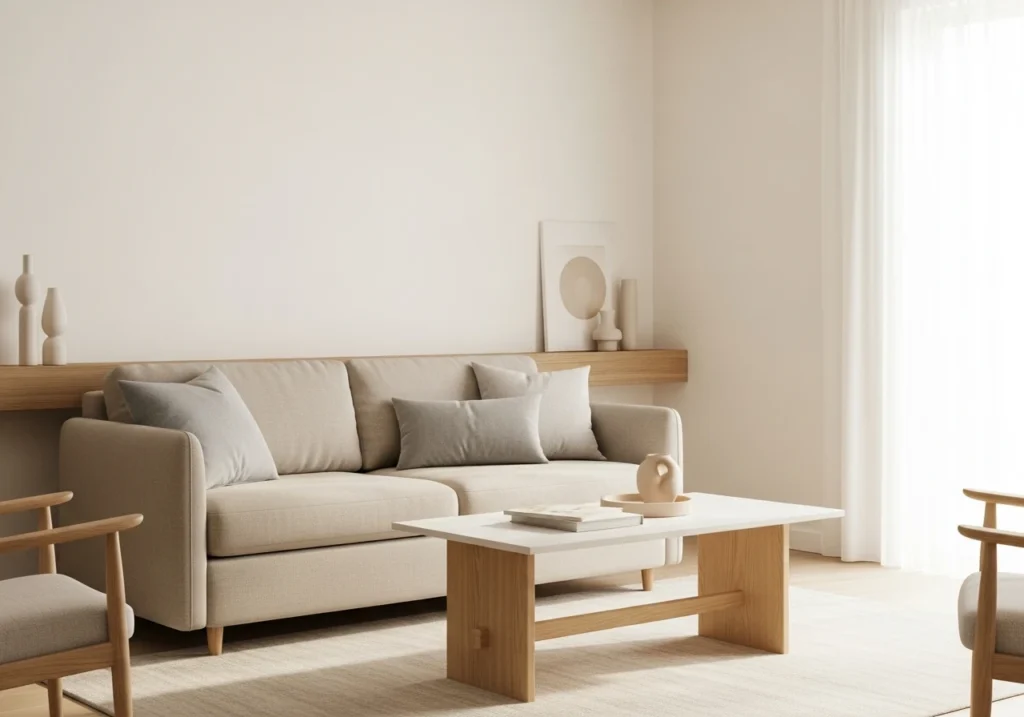
Functional Furniture Choices
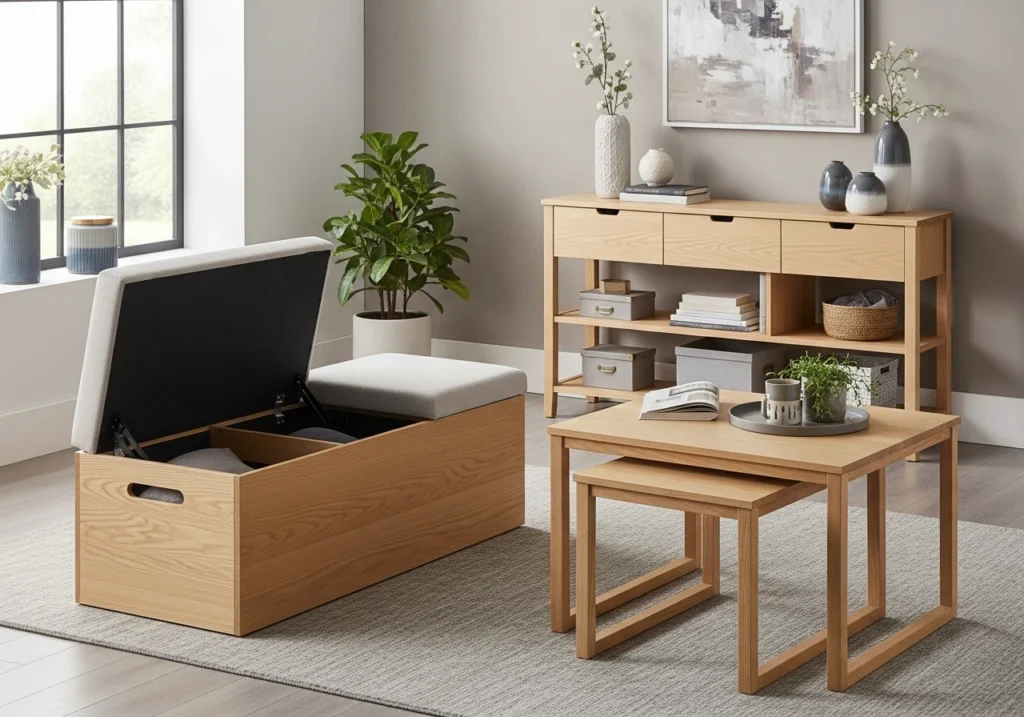
Every piece of furniture in your minimalist living room should earn its place through function, form, or both. Storage ottomans, nesting tables, and sofas with built-in storage are your friends here.
Consider a coffee table with hidden storage for remotes and magazines, or a console table that doubles as a workspace. The key is choosing pieces that solve problems while maintaining clean aesthetic lines.

Creating Your Minimalist Living Room: Step by Step
Step 1: Declutter First, Design Second
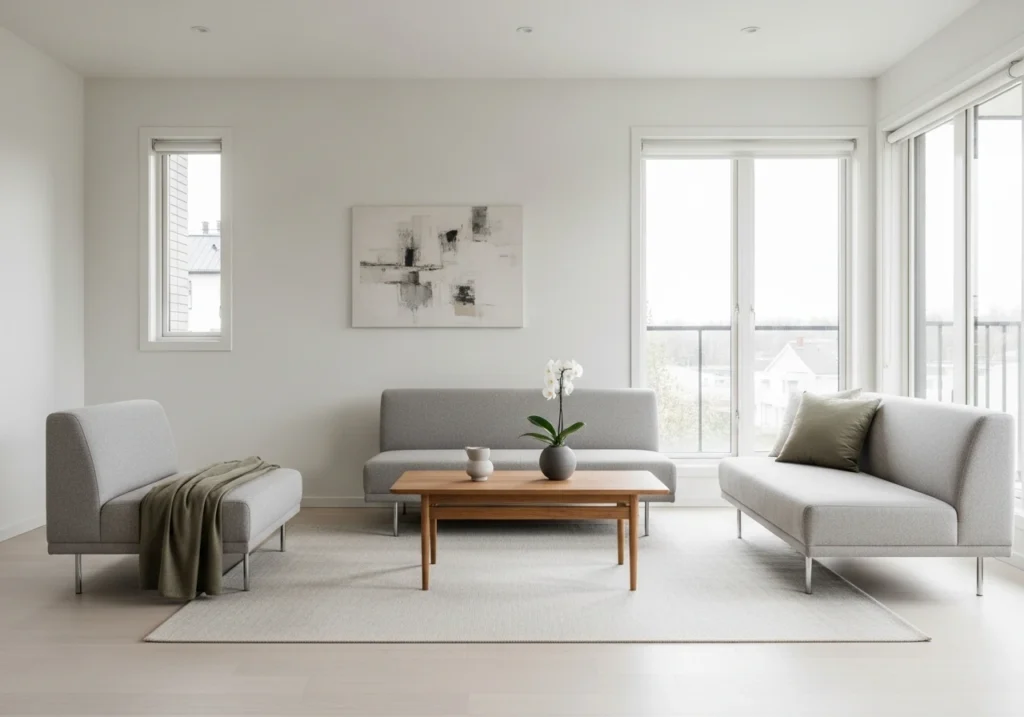
Before you buy a single new piece, you need to declutter what you already have. I know, I know—this isn’t the fun part. But trust me, you can’t create a minimalist space on top of existing clutter.
Start by removing everything from your living room yes, everything. Then, only bring back pieces that you absolutely love or need. This might seem extreme, but it’s the fastest way to see what you’re really working with.
Step 2: Choose Your Foundation Pieces
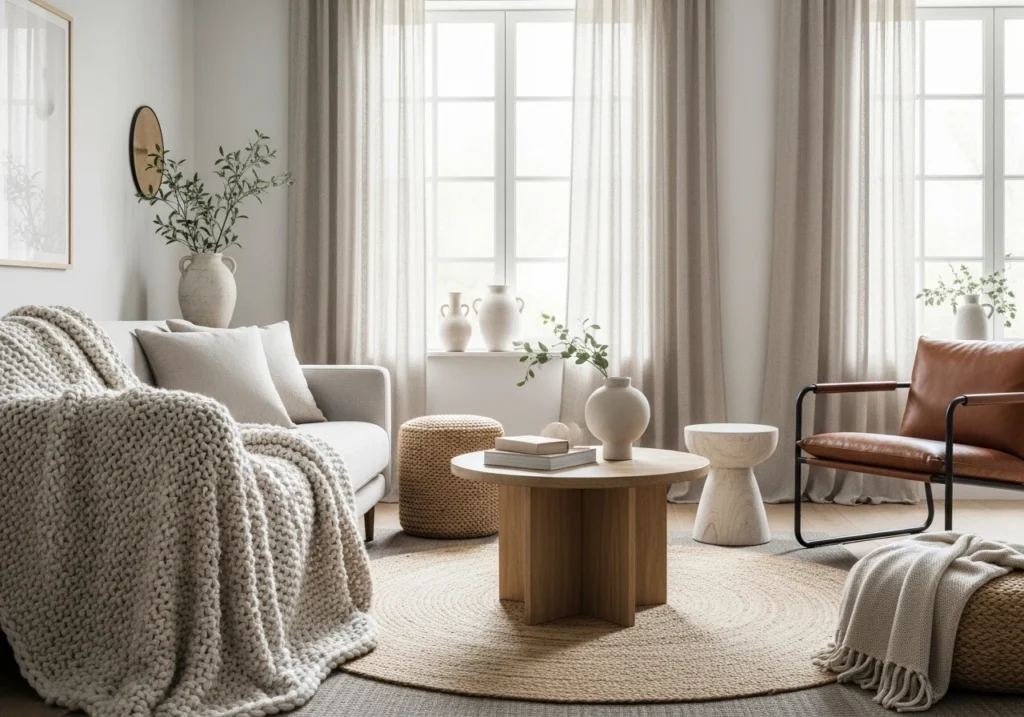
Your foundation pieces are the heavy hitters: your sofa, coffee table, and any large storage pieces. These should be neutral in color and simple in design because they’ll anchor your entire room.
When selecting a minimalist sofa, look for clean lines and avoid overstuffed or overly decorative options. A sectional can work beautifully in a minimalist space if it has simple lines and doesn’t overwhelm the room.
Step 3: Focus on Lighting
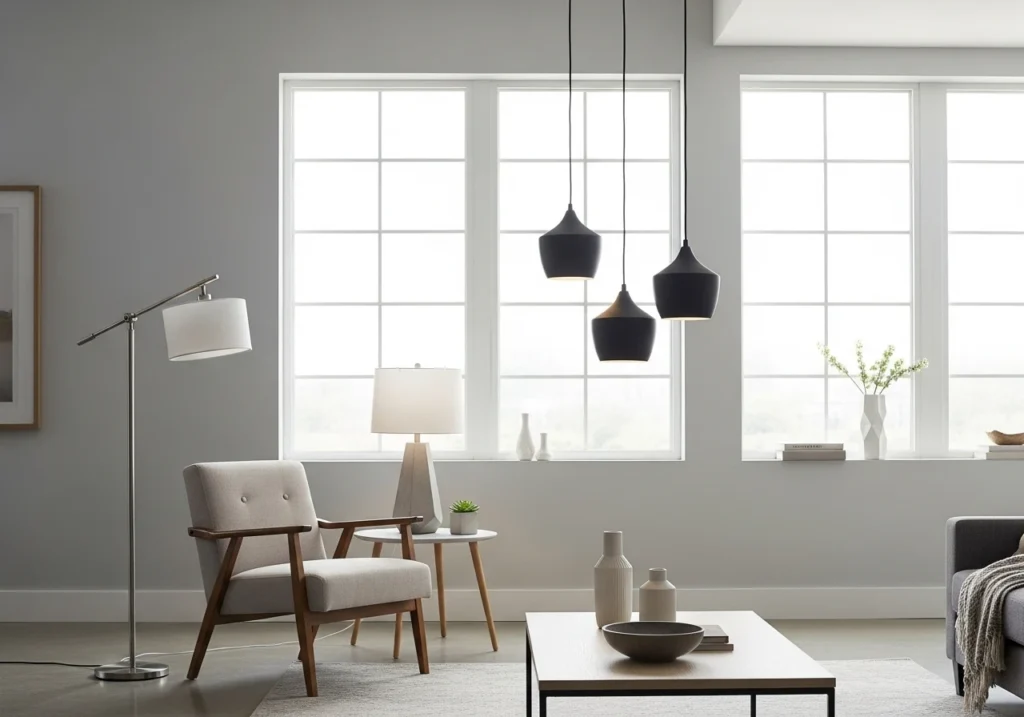
Lighting is crucial in minimalist living room design because you’re relying on ambiance rather than decorative objects to create interest. Natural light should be your first priority keep window treatments simple and avoid heavy curtains that block light.
For artificial lighting, think about layering: ambient lighting from ceiling fixtures, task lighting from table lamps, and accent lighting from floor lamps or wall sconces. Each light source should have clean, simple lines that complement your overall design.

Step 4: Add Texture, Not Clutter
Here’s a secret about minimalist design: texture is everything. Since you’re working with a limited color palette and fewer decorative objects, texture becomes your tool for creating visual interest.
Think about incorporating different textures through:
- A chunky knit throw on your sofa
- A jute or wool area rug
- Linen curtains instead of synthetic materials
- A leather accent chair
- Natural wood furniture pieces
These textural elements add warmth and depth without adding visual clutter.
Common Minimalist Design Mistakes to Avoid
Mistake 1: Making It Too Cold
The biggest mistake I see in minimalist living rooms is creating a space that feels more like a museum than a home. Just because you’re embracing minimalism doesn’t mean you need to eliminate all personality.
Personal touches like family photos (displayed simply), books, or meaningful art pieces can absolutely belong in a minimalist space. The key is being selective and intentional about what you display.
Mistake 2: Forgetting About Comfort
Minimalism should enhance your life, not make it less comfortable. Don’t choose a rock-hard sofa just because it has clean lines, and don’t eliminate all soft textures in favor of hard surfaces.
Your minimalist living room should be a place where you actually want to spend time. Comfort and minimalism can absolutely coexist.
Mistake 3: Going Too Monochromatic
While neutral colors are a hallmark of minimalist design, a room that’s entirely one color can feel flat and lifeless. Incorporate different shades within your neutral palette, and don’t be afraid to add black accents for contrast.
Maximizing Functionality in Small Spaces
If you’re working with a small living room, minimalist principles can actually make your space feel larger and more functional. Here’s how:
Use Vertical Space Wisely

Tall, narrow shelving units draw the eye upward and make ceilings feel higher. Just remember to style them minimally a few books, a plant, and maybe one decorative object per shelf.
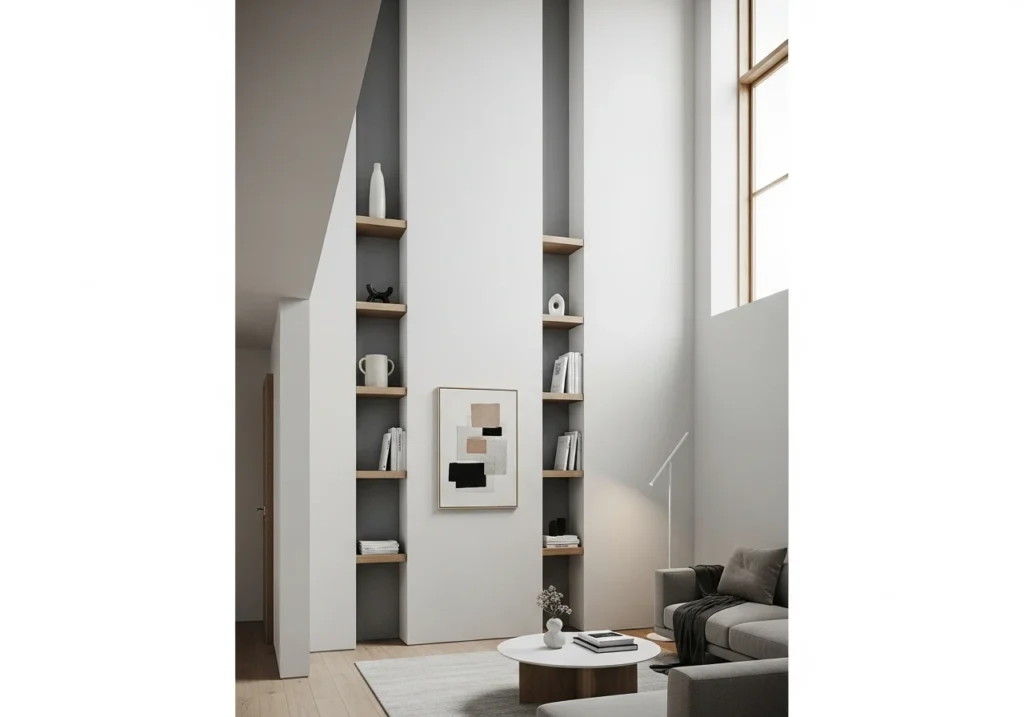
Choose Multi-Functional Pieces
In a small minimalist living room, every piece needs to work harder. Storage ottomans, nesting tables, and console tables that double as desks are invaluable.
Create Visual Flow
Avoid blocking sight lines with furniture. Position pieces so you can see from one end of the room to the other, which creates the illusion of more space.
Incorporating Personal Style
Now here’s where it gets interesting how do you make a minimalist living room feel like your minimalist living room? The answer lies in the details you choose to keep.
Maybe you’re passionate about photography, so you display one large, stunning print instead of a gallery wall. Or perhaps you love plants, so you choose one or two statement plants instead of cluttering every surface with small pots.
The key is identifying what brings you joy and finding ways to incorporate those elements without compromising the clean, uncluttered aesthetic you’re working toward.
Maintenance and Long-Term Success
Creating a minimalist living room is one thing; maintaining it is another. The beauty of minimalist design is that it’s actually easier to keep clean and organized, but only if you stick to your principles.
Establish a “one in, one out” rule for every new item you bring into your living room, something else needs to go. This prevents the gradual accumulation of clutter that can sabotage your minimalist design.
Also, do a monthly assessment of your space. Are there items that have crept in that don’t serve your minimalist goals? Remove them before they multiply.
The Psychology Behind Minimalist Spaces
There’s real science behind why minimalist living rooms feel so calming. Cluttered spaces increase cortisol levels your stress hormone while clean, organized spaces promote relaxation and focus.
When you’re surrounded by fewer visual distractions, your brain can actually rest. This is why spending time in a well-designed minimalist living room can feel so restorative.
Conclusion: Your Journey to Minimalist Living
Creating a minimalist living room isn’t about following a strict set of rules it’s about understanding the principles and adapting them to your life. Start small, be patient with the process, and remember that minimalism is a journey, not a destination.
The goal isn’t to create a picture-perfect room that looks like it belongs in a magazine. The goal is to create a space that supports your life, reduces stress, and brings you genuine joy every time you walk into it.
Whether you’re starting from scratch or slowly transitioning your current space, remember that true minimalist design is about intentionality. Every choice you make should serve both function and beauty, creating a living room that’s not just minimalist in appearance, but minimalist in the very best sense purposeful, peaceful, and perfectly suited to your life.
Take your time, trust the process, and soon you’ll have a living room that proves that when it comes to great design, less really can be more.
Ready to start your minimalist living room transformation? Begin with just one area—maybe your coffee table or bookshelf and apply these principles. You’ll be amazed at how much calmer your space feels with just that small change.

